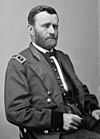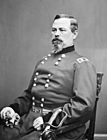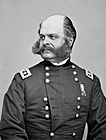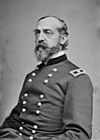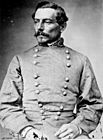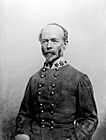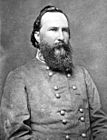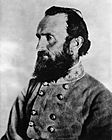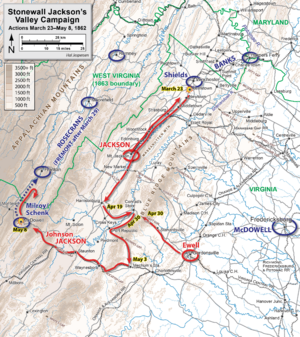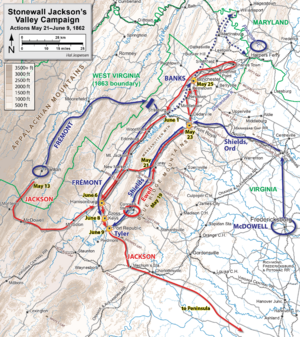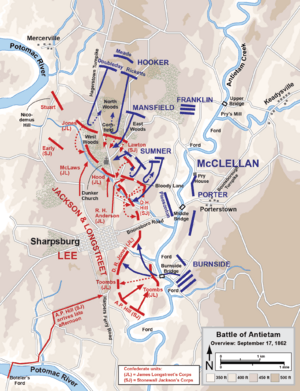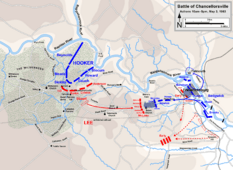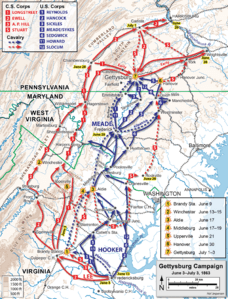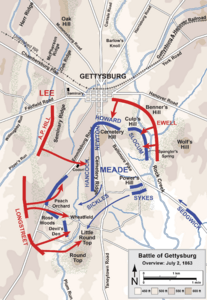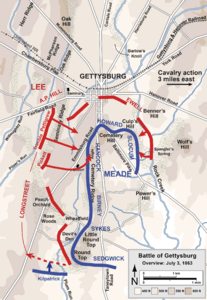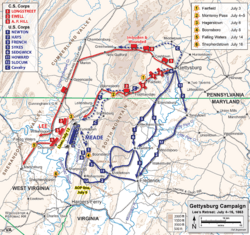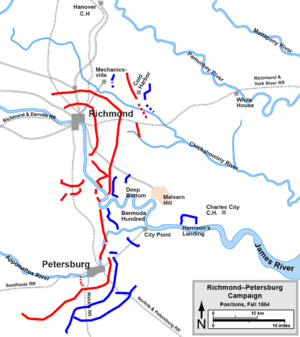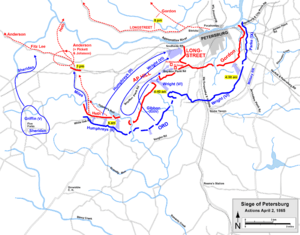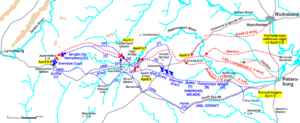Eastern theater of the American Civil War facts for kids

The eastern theater of the American Civil War was where many important battles happened. This area included Virginia, West Virginia, Maryland, Pennsylvania, District of Columbia, and the coastal parts of North Carolina. It was a key battleground because it was close to the capitals of both sides: Washington, D.C. for the Union and Richmond, Virginia for the Confederacy.
The Union's main army in the East, the Army of the Potomac, often tried to capture Richmond. But the Confederate Army of Northern Virginia, led by General Robert E. Lee, was very strong. President Abraham Lincoln kept changing generals for the Union army, trying to find someone who could beat Lee. Generals like George B. McClellan, John Pope, Ambrose Burnside, Joseph Hooker, and George G. Meade all led the Union forces.
In July 1863, General Meade won a big victory over Lee at the Battle of Gettysburg. But it wasn't until Ulysses S. Grant came from the western theater in 1864 that the Union finally captured Richmond. This happened after many bloody battles and a long siege near Petersburg and Richmond. Lee's army finally surrendered at Appomattox Court House in April 1865, ending the major fighting in this area.
Besides the battles between Washington and Richmond, there were other important fights. In 1861, Union forces secured western Virginia, which later became the state of West Virginia. Union troops also took control of Confederate ports in Virginia and North Carolina. The Shenandoah Valley saw many battles in 1862, 1863, and 1864. Lee even tried to invade Union territory twice to make the North want to end the war. His first invasion in 1862 led to the Battle of Antietam. His second invasion in 1863 went into Pennsylvania, further north than any other major Confederate army. In 1864, after Confederates attacked Washington, D.C., Union forces under Philip H. Sheridan fought in the Shenandoah Valley. This stopped the Confederacy from getting food supplies for Lee's army.
Contents
- Why Was the Eastern Theater Important?
- Who Were the Main Commanders?
- Early Fights (1861)
- North Carolina Coast (1861–1865)
- The Shenandoah Valley (1862)
- The Peninsula Campaign (1862)
- Northern Virginia and Maryland (1862)
- Fredericksburg and Chancellorsville (1862–1863)
- Gettysburg and Later (1863)
- Grant vs. Lee (1864–1865)
- Shenandoah Valley (1864–1865)
- Appomattox (1865)
- Major Land Battles
- See also
Why Was the Eastern Theater Important?
The eastern theater is famous for many reasons. It was close to major cities and newspapers, so people on both sides heard a lot about the battles. The main armies, Lee's Confederate Army of Northern Virginia and the Union Army of the Potomac, fought epic battles here.
- The Battle of Gettysburg was the bloodiest battle of the war.
- The Battle of Antietam was the bloodiest single day of the war.
Both Washington, D.C., and Richmond were attacked or surrounded. Some historians say the western theater was more important for winning the war. But for most people at the time, the war didn't feel over until Lee surrendered at Appomattox Courthouse in 1865.
The land in this theater was often difficult for the Union. Rivers ran from west to east, making them barriers for Union armies trying to move south. This was different from the western theater, where rivers often helped armies move. Roads were also bad, especially in winter, which slowed down fighting. However, the Union had an advantage: they controlled the sea and major rivers, allowing them to resupply their armies easily if they stayed near the coast.
Who Were the Main Commanders?
Here are some of the most important generals who led armies in the eastern theater:
-
Lt. Gen.
Ulysses S. Grant,
USA -
Maj. Gen.
George B. McClellan,
USA -
Maj. Gen.
Irvin McDowell,
USA -
Maj. Gen.
John Pope,
USA -
Maj. Gen.
Ambrose Burnside,
USA -
Maj. Gen.
Joseph Hooker,
USA -
Maj. Gen.
George G. Meade,
USA
-
Gen.
Robert E. Lee,
CSA -
Gen.
P.G.T. Beauregard,
CSA -
Gen.
Joseph E. Johnston,
CSA -
Lt. Gen.
James Longstreet,
CSA -
Lt. Gen.
Stonewall Jackson,
CSA -
Maj. Gen.
A.P. Hill,
CSA -
Maj. Gen.
Jubal A. Early,
CSA
Early Fights (1861)
After the attack on Fort Sumter in April 1861, both sides quickly tried to build armies. President Lincoln asked for 75,000 volunteers to stop the rebellion. This led four more states, including Virginia, to leave the Union. The U.S. Army was very small, with most soldiers far away in the West.
Some of the first fights happened in western Virginia. Union Maj. Gen. George B. McClellan led troops who attacked Confederates. His victory at the Battle of Rich Mountain in July helped him become commander of the Army of the Potomac later that year. The Union won in this area, which helped create the new state of West Virginia in 1863.
The first important battle in eastern Virginia was on June 10. Union forces attacked Confederate outposts near Fort Monroe. At the Battle of Big Bethel, the Confederates won their first victory.
First Battle of Bull Run
In the summer of 1861, Union General Irvin McDowell led about 35,000 inexperienced soldiers. Politicians and newspapers pushed him to attack the Confederates near Manassas. His plan was to attack 20,000 Confederates led by Brig. Gen. P.G.T. Beauregard. Another Confederate force of 12,000 men under Gen. Joseph E. Johnston was in the Shenandoah Valley. The Union hoped to keep Johnston busy so he couldn't join Beauregard.
On July 21, McDowell's army attacked Beauregard's forces in the First Battle of Bull Run (also called First Manassas). The Union troops started well, pushing back the Confederates. But in the afternoon, the battle changed. Brig. Gen. Thomas J. Jackson inspired his troops to hold strong, earning him the famous nickname "Stonewall." Also, Johnston's army arrived by train, helping the Confederates. The Union soldiers began to retreat, and it turned into a panicked run back towards Washington, D.C. This Union defeat shocked the North. Everyone realized the war would be long and bloody.
After this, George B. McClellan was called to the East in August to lead the new Army of the Potomac. He was good at organizing and training soldiers. By November, he became the general-in-chief of all Union armies.
North Carolina Coast (1861–1865)
North Carolina was important to the Confederacy because of the port of Wilmington. Also, the Outer Banks islands were good places for ships trying to get around the Union Blockade. In August 1861, Union forces captured batteries at Hatteras Inlet. In February 1862, Brig. Gen. Ambrose Burnside led an attack that captured Roanoke Island, an important Union victory.
Later, in late 1864, Union forces tried to capture Fort Fisher, which protected Wilmington. They failed the first time. But in January 1865, Union forces led by Alfred H. Terry succeeded at the Second Battle of Fort Fisher. Wilmington fell in February. Around this time, Maj. Gen. William T. Sherman's Union armies were marching through the Carolinas. They eventually forced the surrender of the last large Confederate army under Joseph E. Johnston in April 1865.
The Shenandoah Valley (1862)
In spring 1862, the Union armies were doing well in the West. In the East, George B. McClellan's huge Army of the Potomac was moving towards Richmond. Other Union forces threatened Richmond from the north and the rich farmlands of the Shenandoah Valley. The Confederates turned to Maj. Gen. Stonewall Jackson to help. His job was to keep Union forces busy in the Valley so they couldn't join McClellan.
Jackson's cavalry raided Union supply lines. Union General Nathaniel P. Banks moved into the Valley to protect these lines. Jackson was outnumbered, but he wanted to keep Banks from sending troops to McClellan. Jackson attacked a Union force at the First Battle of Kernstown on March 23, 1862. He lost the battle, but it was a strategic win for the Confederates. It made President Lincoln keep Union troops in the Valley and near Fredericksburg, preventing about 50,000 soldiers from joining McClellan's attack on Richmond.
After Kernstown, the Union reorganized. Three separate Union commands were ordered to defeat Jackson. Jackson, now with 17,000 men, decided to attack the Union forces one by one. He first fought Robert Milroy at the Battle of McDowell on May 8 and pushed back the Union army.
Jackson then turned to Banks. He marched his troops quickly, earning them the nickname "Jackson's foot cavalry." On May 23, at the Battle of Front Royal, Jackson surprised and defeated a Union outpost. This forced Banks to retreat quickly towards Winchester. On May 25, at the First Battle of Winchester, Jackson's army soundly defeated Banks's army, which then withdrew across the Potomac River.
President Lincoln decided that defeating Jackson was very important. He ordered Union forces to try and trap Jackson in the Valley. Jackson, however, marched his army forty miles in thirty-six hours to escape. He took defensive positions at Cross Keys and Port Republic, where he defeated Union forces on June 8 and 9.
After these battles, Union forces left the Valley. Jackson then joined Robert E. Lee for the Seven Days Battles near Richmond. He had succeeded in his mission, keeping over 50,000 Union troops away from McClellan. Jackson became a hero in the Confederacy. In 48 days, his army marched 646 miles and won five big victories against much larger Union forces.
The Peninsula Campaign (1862)
Template:Campaignbox Seven Days Battles
George B. McClellan spent the winter of 1861–62 training his Army of the Potomac. President Lincoln wanted him to attack the Confederates near Washington. But McClellan thought the Confederate army was much stronger than it was. He decided to attack the Confederate capital of Richmond by sailing his army to Fort Monroe and then marching up the Virginia Peninsula. Lincoln reluctantly agreed.
Before leaving, McClellan moved his army to Centreville and found out the Confederate forces there were actually quite weak. On March 11, Lincoln removed McClellan as general-in-chief, so he could focus on this campaign. The army started sailing to Fort Monroe on March 17. There was concern about new ironclad ships like the CSS Virginia and the USS Monitor after their fight at the Battle of Hampton Roads.
Lincoln also stopped Irvin McDowell's corps from joining McClellan, because McClellan hadn't left enough troops to protect Washington, and Jackson's Valley Campaign was worrying. McClellan complained, but he moved forward anyway.
Marching Up the Peninsula
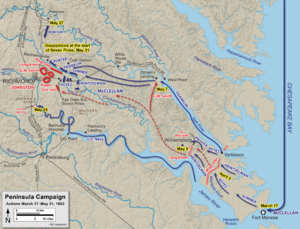
The Union army reached Yorktown but stopped because Confederate defenses stretched across the Peninsula. McClellan spent about a month building up his forces for a siege. But Confederate General Johnston decided his defenses were too weak and pulled back during the night of May 3–4. Union forces chased the Confederates towards Richmond. They fought an undecided battle at Williamsburg.
By late May, the Union army was a few miles from Richmond. McClellan was very cautious. He thought the Confederate army was twice his size, but it was actually the other way around. Confederate General John B. Magruder tricked McClellan by marching small groups of soldiers past the same spot many times, making them look like a huge army.
As the Union army got close to Richmond, it became split by the Chickahominy River. McClellan kept most of his army north of the river, waiting for McDowell's troops. Only two Union corps were south of the river. Confederate President Jefferson Davis and Robert E. Lee pushed Johnston to attack this smaller Union force south of the river. They hoped the flooded Chickahominy would stop McClellan from sending help.
The Battle of Seven Pines (also called Fair Oaks), fought on May 31 – June 1, 1862, didn't go as Johnston planned. Confederate attacks were uncoordinated, and Union reinforcements managed to cross the river. The battle was a draw, but it had two big effects:
- Johnston was wounded and replaced by the more aggressive General Robert E. Lee.
- McClellan stopped his attack and decided to wait for more troops. He never got his momentum back.
Lee used the next month to build stronger defenses around Richmond. He also sent J.E.B. Stuart's cavalry to ride all the way around the Union army to find out where its end was. Lee also called Jackson's troops from the Valley to reinforce him. McClellan moved most of his army south of the Chickahominy, leaving only one corps north of the river.
The Seven Days Battles
Lee then went on the attack, fighting a series of battles for seven days (June 25 – July 1). He pushed McClellan's army back to a safe spot on the James River. McClellan actually attacked first on June 25 at the Battle of Oak Grove. Lee then attacked at Mechanicsville on June 26. Lee saw that McClellan's army was split by the river and hoped to defeat parts of it. Jackson was late, and Lee's first attack failed. Even though the Union won this battle, McClellan ordered his troops to retreat south.
Lee continued his attacks at the Gaines's Mill on June 27. This was the largest Confederate attack of the war. The Union lines held for most of the day, but Lee eventually broke through. McClellan retreated again, heading for a safe base on the James River.
The next two days saw smaller battles at Garnett's and Golding's Farm and Savage's Station as McClellan continued his retreat. At the Battle of Glendale on June 30, Lee tried to cut off the Union retreat, but Jackson's poor performance meant the Union army escaped.
The last battle of the Seven Days was on July 1 at Malvern Hill. Confederate attacks were not coordinated and were easily stopped by Union defenses and naval guns. Lee's army lost over 5,600 men, while the Union lost only 3,000. McClellan ordered his army to retreat to Harrison's Landing.
The Seven Days Battles ended the Peninsula Campaign. The Army of the Potomac stayed safe on the James River until August, when Lincoln ordered them to leave. Lincoln was unhappy with McClellan and appointed Henry W. Halleck as general-in-chief of all Union armies.
Both sides suffered many losses. Lee's army lost almost 20,000 men, and McClellan's lost almost 16,000. The North was sad about McClellan's retreat. But the Confederates were very happy, and Lee felt confident to continue his aggressive plans.
Northern Virginia and Maryland (1862)
After beating McClellan, Lee started two new campaigns. He wanted to defeat another Union army threatening Richmond, and then invade Maryland.
The Army of Virginia
President Lincoln put John Pope in charge of a new army, the Army of Virginia. Pope was known for being aggressive. His job was to protect Washington and the Shenandoah Valley, and to draw Confederate forces away from McClellan.
Lee realized McClellan was no longer a threat. He moved Stonewall Jackson's troops to block Pope. Lee had a bigger plan: to defeat Pope's army before McClellan's army could join it. Lee sent more troops to Jackson.
On August 9, Union General Nathaniel P. Banks attacked Jackson at Cedar Mountain. The Union gained an early lead, but a Confederate counterattack pushed Banks back. Jackson then learned that all of Pope's corps were together, so his plan to defeat them separately failed.
On August 13, Lee sent James Longstreet to reinforce Jackson. Lee himself arrived on August 15. His plan was to cut Pope's supply lines and attack his army from behind. But Pope found out about Lee's plan and pulled his army back.
Lee then decided to send Jackson and Stuart with half the army on a long march around Pope's right side. They would cut Pope's supply line, the Orange & Alexandria Railroad. This would force Pope to retreat, making him vulnerable to attack.
On August 26, Jackson's troops reached the railroad and destroyed a huge Union supply depot at Manassas Junction. This surprise move forced Pope to leave his defenses and move towards Manassas Junction, hoping to defeat Jackson before Lee's other troops arrived. On August 27–28, Jackson moved his divisions to the old First Bull Run battlefield. Longstreet's troops arrived, uniting Lee's army.
Second Battle of Bull Run
To make Pope's army fight, Jackson attacked a Union column on August 28. This started the Second Battle of Bull Run. The fighting lasted hours and was a draw. Pope thought he had trapped Jackson and focused most of his army on him. On August 29, Pope attacked Jackson's position many times, but the Confederates held strong. Longstreet's troops arrived at noon and joined Jackson's right side.
On August 30, Pope attacked again, not knowing Longstreet was there. When Confederate artillery destroyed a Union attack, Longstreet's 28,000 men counterattacked. This was the largest mass attack of the war. The Union left side was crushed, and the army was pushed back to Bull Run. A strong Union rear guard stopped it from becoming a disaster like the First Bull Run. Pope's retreat to Centreville was very fast. Lee ordered his army to chase them.
Jackson tried to cut off the Union retreat. On September 1, Jackson's divisions attacked two Union divisions at the Battle of Chantilly. Fierce fighting in a thunderstorm stopped the Confederates. Both Union division commanders were killed. Pope realized his army was still in danger and ordered them to keep retreating to Washington.
Lee Invades Maryland
Lee decided his army, despite heavy losses, was ready to invade the North. He wanted to go into Maryland and Pennsylvania to cut off the railroad that supplied Washington. He also needed supplies for his army, knowing Northern farms hadn't been touched by war. He hoped to lower Northern spirits and perhaps force Lincoln to end the war.
The Army of Northern Virginia crossed the Potomac River and reached Frederick, Maryland, on September 6. Lee planned to move towards Harrisburg, Pennsylvania, and then maybe attack cities like Philadelphia. News of the invasion caused panic in the North. Lincoln put George B. McClellan back in command of all forces around Washington and told him to stop Lee.
Lee split his army. Longstreet went to Hagerstown. Jackson was ordered to capture the Union arsenal at Harpers Ferry, which controlled Lee's supply lines. McClellan asked to evacuate Harpers Ferry, but Lincoln refused. In the Battle of Harpers Ferry, Jackson used artillery to force over 12,000 Union soldiers to surrender on September 15. Jackson then rejoined Lee's main army.
McClellan moved slowly out of Washington with his 87,000-man army. On September 13, two Union soldiers found a copy of Lee's detailed battle plans, wrapped around three cigars. The plans showed that Lee had split his army, making it vulnerable. McClellan waited 18 hours before acting on this information, almost losing his chance. That night, the Union army moved towards South Mountain. At the Battle of South Mountain on September 14, Union forces pushed back the Confederates. McClellan was now in a position to destroy Lee's army before it could reunite.
Lee realized his plans were known. He decided not to retreat to Virginia. Instead, he chose to make a stand at Sharpsburg, Maryland.
The Battle of Antietam
On September 16, McClellan faced Lee near Sharpsburg, along Antietam Creek. At dawn on September 17, the Battle of Antietam began. Union attacks hit Lee's left side. Fierce fighting happened in the Miller Cornfield and near the Dunker Church. Union attacks also broke through the Confederate center at the "Bloody Lane." But McClellan didn't send in his reserve troops to finish the job.
In the afternoon, Burnside's corps crossed a stone bridge and attacked the Confederate right. Just when it looked bad for Lee, A.P. Hill's division arrived from Harpers Ferry. They counterattacked, pushing back Burnside's men and saving Lee's army. Lee used all his troops, even though he was outnumbered two to one. McClellan used less than three-quarters of his army. This allowed Lee to move his brigades around to stop each Union attack.
With over 23,000 casualties, Antietam was the bloodiest single day in American history. Lee ordered his damaged army to retreat back to Virginia. Even though the battle was a tactical draw, it was a strategic victory for the Union. Lee's invasion of Maryland failed. More importantly, President Lincoln used this moment to announce his Emancipation Proclamation. After this, European countries were much less likely to help the Confederacy.
Fredericksburg and Chancellorsville (1862–1863)
On November 7, 1862, President Lincoln removed McClellan from command because he didn't chase Lee's army after Antietam. Ambrose Burnside was put in charge of the Army of the Potomac. Lincoln wanted him to attack quickly. Burnside planned to march south towards Richmond. He hoped to get around Lee's army by crossing the Rappahannock River at Fredericksburg. But his bridging boats didn't arrive on time. This gave Lee time to build strong defenses on the heights behind Fredericksburg.
Instead of finding another way, Burnside crossed the river. On December 13, he launched huge frontal attacks against Marye's Heights, a fortified Confederate position. The Union army lost over 12,000 men that day, while Confederate losses were about 4,500.
Even after this defeat, Burnside wasn't immediately removed. He planned another attack, but it failed in January 1863 in what was called the "Mud March." His generals then told the government that Burnside couldn't lead the army. One of these generals was Maj. Gen. Joseph Hooker, who took command of the Army of the Potomac on January 26, 1863. Hooker spent the winter getting his army ready and improving morale. He planned a complex spring campaign against Lee.
|
Hooker planned to send his cavalry deep behind Confederate lines to cut supplies. While one corps kept Lee busy at Fredericksburg, the rest of Hooker's army would sneak around Lee's flank. Lee had sent a corps of his army away to find food, so he was outnumbered 57,000 to 97,000.
The plan started well. Most of the Army of the Potomac crossed the Rapidan River and were in position by May 1. But after a small fight, Hooker lost his confidence. Instead of attacking Lee's rear, he pulled back to a defensive position around Chancellorsville. On May 2, Robert E. Lee made a very bold move. He had already split his army to face Hooker's attack. Now, he split it again. He sent 20,000 men under Stonewall Jackson on a long march to attack Hooker's unprotected right side. Jackson's surprise attack routed the Union XI Corps. After this success, Jackson was accidentally shot by his own men while scouting and later died.
While Lee attacked the Chancellorsville defense line on May 3, the Union VI Corps finally captured Marye's Heights in Fredericksburg. This corps then moved west, threatening Lee's rear again. Lee managed to deal with both Union forces. By May 7, Hooker pulled all his forces back north of the Rappahannock. It was a costly victory for Lee, who lost 13,000 men (25% of his army). Hooker lost 17,000, but his army was much larger.
Gettysburg and Later (1863)
In June 1863, Robert E. Lee decided to invade the North again, hoping to repeat his success from 1862. He wanted to get supplies for his army, give Virginia farmers a break, and lower Northern morale. He hoped to capture a Northern city like Harrisburg, Pennsylvania, or Baltimore. Lee's army was now organized into three corps.
Lee moved his army northwest into the Shenandoah Valley. Union General Joseph Hooker, still in command, sent cavalry to find Lee. On June 9, a large cavalry battle happened at Brandy Station, but it didn't have a clear winner. Hooker chased Lee's army. On June 28, President Lincoln, frustrated with Hooker, replaced him with Maj. Gen. George G. Meade. Meade ordered his army to advance into southern Pennsylvania to protect Washington and Baltimore and find Lee's army.
Lee was surprised by how fast the Union army was moving. His troops were spread out in Pennsylvania. His cavalry, under Jeb Stuart, was out of touch, leaving Lee blind to the Union army's location. Lee realized he had to gather his army before it could be defeated in pieces. He ordered all units to move towards Gettysburg, Pennsylvania.
|
The Battle of Gettysburg is often seen as the turning point of the war. Meade defeated Lee in a three-day battle involving 160,000 soldiers and causing 51,000 casualties. It started on July 1 when Confederate and Union forces clashed. The Union troops were pushed back through the town but took strong defensive positions on high ground south of Gettysburg.
On July 2, Lee launched huge attacks against the left and right sides of Meade's army. Fierce battles took place at Little Round Top, Devil's Den, the Wheatfield, the Peach Orchard, East Cemetery Hill, and Culp's Hill. Meade moved his defenders along inner lines and stopped the Confederate attacks.
On July 3, Lee ordered Pickett's Charge against the Union center. Almost three Confederate divisions were destroyed. Jeb Stuart's cavalry returned and fought a battle east of the main field. The two armies stayed in position on July 4 (the same day the Battle of Vicksburg ended with a Union victory in the West). Then Lee ordered a retreat back to Virginia.
Meade's chase of Lee was slow and didn't succeed. He was criticized for not ending the war after Gettysburg. In October, some of Meade's army was sent to the western theater. Lee saw this as a chance to defeat the Union army and threaten Washington. But the Bristoe Campaign ended with Lee retreating back to the Rapidan River. Meade then launched one more attack in the fall, the Mine Run Campaign. But Lee built strong defenses, and Meade decided not to attack, retreating to his winter camps.
Grant vs. Lee (1864–1865)
In March 1864, Ulysses S. Grant became the commander of all Union armies. He planned a coordinated strategy to attack the Confederacy from many directions. Grant put William T. Sherman in charge of forces in the West. Grant himself stayed with the Army of the Potomac in Virginia, planning to fight Lee's army. His main goal was to defeat Lee, knowing that Richmond would fall once Lee's army was beaten.
Grant's plan involved several attacks:
- Grant and Meade would attack Lee from the north.
- Benjamin Butler would move towards Richmond from the southeast.
- Franz Sigel would control the Shenandoah Valley.
- Sherman would invade Georgia and capture Atlanta.
- George Crook and William W. Averell would attack railroad supply lines in West Virginia.
Many of these attacks didn't go as planned. Butler's army got stuck near Richmond in the Bermuda Hundred Campaign. Sigel was defeated at the Battle of New Market and replaced. But Crook and Averell did cut a key railway. Sherman's Atlanta campaign was a success, though it took a long time.
The Overland Campaign
In early May, the Army of the Potomac crossed the Rapidan River into a dense forest called the Wilderness of Spotsylvania. Here, the thick woods made the Union's artillery advantage useless. Robert E. Lee surprised Grant and Meade with aggressive attacks. The two-day Battle of the Wilderness was a draw, but it caused many Union casualties.
However, unlike past Union generals, Grant didn't retreat. He moved his army southeast, starting a campaign of constant movement and bloody battles that kept Lee on the defensive. Grant knew his larger army and the North's ability to replace soldiers meant he could win a war of attrition. Grant lost about 55,000 men, but Lee lost an even higher percentage of his army, losses he couldn't replace.
At the Battle of Spotsylvania Court House, Lee reached the town first and set up strong defenses. For two weeks, Grant attacked Lee's lines, especially at a curved part called the "Mule Shoe." A huge attack by Winfield S. Hancock's corps on May 12, at a spot called the "Bloody Angle," was very intense. Unable to defeat Lee there, Grant again moved his army southeast.
Lee intercepted Grant at the Battle of North Anna and set up his forces to force Grant to divide his army. Lee had a chance to defeat Grant, but he didn't attack. Grant decided against a frontal assault and continued moving southeast.
On May 31, Union cavalry captured the important crossroads of Old Cold Harbor. By June 2, both armies were in position. At dawn on June 3, Union corps attacked the Confederate lines and were slaughtered at the Battle of Cold Harbor. Grant lost over 12,000 men in this battle, which he later regretted deeply. People in the North started calling him a "butcher."
On the night of June 12, Grant again moved his army, marching to the James River. He managed to hide his plans from Lee. His army crossed the river on a pontoon bridge over 2,100 feet long. What Lee had feared most—being forced into a siege of Richmond—was about to happen.
The Siege of Petersburg
Grant decided there was a better way to get Richmond. A few miles south, the city of Petersburg had key rail lines that supplied the capital. If the Union could capture Petersburg, Richmond would fall. Grant's subordinates failed to break through the thin Confederate lines, allowing Lee's army to arrive and strengthen the defenses. Both sides then settled into a long siege.
To break the siege, Union troops dug a tunnel under the Confederate line. On July 30, they blew up the explosives, creating a huge crater. Almost 350 Confederate soldiers died instantly. But the Battle of the Crater was poorly managed by the Union, leading to a big Confederate victory.
Through the fall and winter, both armies built long lines of trenches, stretching over 30 miles. The Union army tried to get around the Confederate right side and cut their supply lines. The Northern public became discouraged by the slow progress at Petersburg. But Union victories by William Sherman in Atlanta, and by David Farragut at Mobile Bay, helped Lincoln win re-election in 1864. This meant the war would continue until the Confederacy was defeated.
Shenandoah Valley (1864–1865)
The Shenandoah Valley was very important to the Confederacy. It was a major farming area in Virginia and a good route for invading the North. Grant hoped a Union army under Franz Sigel could take control of the Valley and destroy the railroad center at Lynchburg. Sigel was defeated at the Battle of New Market on May 15 and was replaced by David Hunter. Hunter won a victory at the Battle of Piedmont on June 5. Hunter began burning Confederate farms and homes, earning him the nickname "Black Dave." He also burned the Virginia Military Institute in Lexington.
Robert E. Lee, stuck in Petersburg, was worried about Hunter's advances. He sent Jubal Early's corps to clear Union forces from the Valley. Early's goal was also to threaten Washington, D.C., hoping to make Grant send troops away from Petersburg. Early started well, pushing back Hunter's force at the Battle of Lynchburg. He marched down the Valley, bypassed Harpers Ferry, crossed the Potomac River, and entered Maryland. Grant sent troops to reinforce Washington and chase Early.
At the Battle of Monocacy (July 9, 1864), Early defeated a smaller Union force. But this battle delayed him enough for Washington's defenses to be strengthened. Early attacked a fort on Washington's defenses (Fort Stevens, July 11–12) but failed and retreated to Virginia. He fought several smaller battles in the Valley through early August. He also burned the city of Chambersburg, Pennsylvania, in revenge for Hunter's actions.
Grant knew Washington was still in danger if Early was free. He found an aggressive new commander to defeat Early: Maj. Gen. Philip Sheridan, the Army of the Potomac's cavalry commander. Sheridan was given command of all Union forces in the area. Sheridan started slowly at first. But in September, he began moving aggressively. He defeated Early at the Third Battle of Winchester on September 19 and the Battle of Fisher's Hill on September 21–22. With Early weakened, the Valley was open to the Union.
Sheridan then slowly moved back down the Valley, burning crops, barns, mills, and factories. This was a "scorched earth" campaign, meant to stop the Confederacy from feeding its armies in Virginia.
The campaign ended at the Battle of Cedar Creek (October 19, 1864). Early launched a surprise attack at dawn and routed two-thirds of the Union army. But his hungry troops stopped to loot the Union camp. Sheridan managed to rally his troops and decisively defeat Early. In late fall, Sheridan sent his infantry to help Grant at Petersburg. Most of Early's corps rejoined Lee at Petersburg in December.
Appomattox (1865)
In January 1865, Robert E. Lee became the general-in-chief of all Confederate armies, but it was too late. The siege of Petersburg continued. Grant tried to break or surround the Confederates with many attacks. He slowly cut off all of their supply lines except two railroads. By March, the siege had taken a huge toll on both armies. Lee decided to leave Petersburg. Maj. Gen. John B. Gordon tried a surprise attack on Fort Stedman on the Union lines. It was a success at first, but his outnumbered corps was pushed back.
Sheridan returned from the Valley and was tasked with getting around the Confederate army. This forced Lee to send forces to defend his flank. Grant then sent cavalry and two infantry corps under Sheridan to cut off these Confederate forces. The Confederates attacked first at Dinwiddie Court House on March 31, pushing back the Union but not gaining a big advantage. They moved to Five Forks that night. On April 1, Sheridan attacked again, surrounding the Confederate left side and capturing over two thousand Confederates. This victory meant Sheridan could capture the South Side Railroad the next day.
After Five Forks, Grant ordered an attack along the entire Confederate line on April 2. This was the Third Battle of Petersburg, and it led to big breakthroughs. During the fighting, A.P. Hill was killed. Lee pulled his forces out of Petersburg and Richmond that day and night. He headed west to Danville, where the Confederate government was fleeing, and then south to meet General Joseph E. Johnston in North Carolina. Richmond surrendered on the morning of April 3.
The campaign became a race between Lee and Sheridan. Lee tried to get supplies for his retreat, and Sheridan tried to cut him off. At Sayler's Creek on April 6, almost a quarter of the Confederate army (about 8,000 men) was cut off and forced to surrender. Many Confederate supply trains were also captured. Grant suggested Lee surrender, but Lee still tried to outmarch the Union forces.
In Lee's final attack at Appomattox on the morning of April 9, John B. Gordon's weakened corps tried to break the Union lines to reach supplies. They pushed back Sheridan's cavalry briefly, but then faced the full Union V Corps. Surrounded on three sides, Lee was forced to surrender his army to Grant at Appomattox Court House that day. The formal surrender happened two days later.
There were still some smaller battles and surrenders of Confederate armies, but Lee's surrender on April 9, 1865, effectively ended the Civil War. Lee wanted to make sure his army didn't scatter and continue fighting as guerrillas, which helped the country begin to heal.
Major Land Battles
Here are some of the costliest land battles in the eastern theater, based on how many soldiers were killed, wounded, captured, or went missing:
See also
 In Spanish: Teatro del Este de la guerra de Secesión para niños
In Spanish: Teatro del Este de la guerra de Secesión para niños
- Bibliography of the American Civil War
- Bibliography of Abraham Lincoln
- Bibliography of Ulysses S. Grant
- List of American Civil War battles
- List of costliest American Civil War land battles


